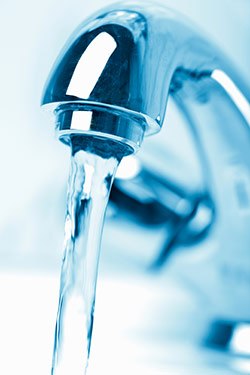
If you live in an area with hard water, a water softener is a very beneficial piece of equipment. Its primary purpose is to eliminate the calcium, magnesium, and other minerals present in the water that could cause limescale build-up in your appliances. Hard water has detrimental effects on your skin and hair, too.
Luckily installing a water softener at home can dramatically improve your water quality. It’s important that you understand how this essential equipment works so you can make an informed decision about how to tackle hard water.
1. What Is a Water Softener?
A water softener is a filtration system installed into a house to remove water hardness caused by minerals, calcium, and magnesium. As the water passes through the filter, the system takes out these minerals, and only softened water will flow into your plumbing system. The goal of a softener is to eliminate problems associated with hard water. Note that water minerals can cause scale build-up in your pipes which form clogs and minimize water pressure. The scale also dramatically lowers the lifespan of appliances like dishwashers and washing machines.
Worse, hard water can quickly destroy your water heater system. High temperatures causes calcium and magnesium to quickly solidify and form deposits at the tank’s bottom. You will then begin to hear some popping sounds once you turn on the water heater. As a result, you might need to buy a new water heater sooner than you’d anticipated, since scale quickly attaches to the heating elements. Installing a whole house water softener will help solve all these problems.
2. How Does it Work?
A technician will install the water softener in your household plumbing close to where the water enters the house. The purification process involves ion exchange. From the main water supply, the water first goes into a mineral tank that contains resin beads. These beads are made from polystyrene saturated with sodium ions. The resin beads are anions, meaning that they are negatively charged, while calcium and magnesium are cations positively charged.
Following the principle that opposite charges attract one another as the water goes through the resin beads, the negative charges attract and hold the minerals removing them from the water. Thus, you will end up with soft water with some traces of sodium. Note that the sodium levels are too low to cause harm, so the water entering your plumbing system is clean and safe to drink.
3. The Regeneration Process
As mentioned earlier, the resin beads collect the minerals in the water during the purification process. After some time, the resin beads will accumulate too many hardness ions, and they may not be able to soften the water adequately. The beads will thus need to undergo a regeneration process for optimum performance.
Water flushes through the mineral tank for about ten minutes. In most systems, this step happens early in the morning. The primary purpose of this step is to loosen and remove any sediments deposited on the resins. During the regeneration process, your tap may provide hard water. Those with a dual tank won’t experience this issue since the flushing happens in one tank at a time.
In the next phase of the regeneration process, the resins undergo more freshwater flush, and at the same time, saltwater flows from the brine tank into the resin tank. The brine washes through the resin beads to discharge the excess ions and replenish them with a fresh sodium layer. The high amount of sodium on the brine solution can wash away the magnesium and calcium ions. The resins then undergo a slow rinse to remove any brine and hardness minerals.
A fast rinse sends excess salt into the drain and packs the resins back to their initial state. The brine tank then refills in preparation for the next regeneration cycle. The regeneration process can take around one to two hours, and your water softener resumes its normal operations. Resin beads are incredibly durable, and they effectively soften your hard water for around 20 years.
4. What Are the Main Components of a Water Softener?
The water softener has three components that work together to remove hard water minerals, regulate water flow, and clean the system. The mineral tank is where water softening takes place. It holds the resin beads that draw minerals from the hard water.
On the other hand, the control valve is the brain of the water softener system. The valve contains a meter to measure the water passing through the mineral tank into your plumbing system and the volume getting into the tank. Also, the control valve senses when the resin beads begin to lose the capacity to soften the water and automatically initiates the regeneration cycle before the beads become too overburdened. During installations, the technician will program the valve to detect the resin’s maximum capacity based on your house size, number of occupants, and the level of water hardness in your area.
The brine tank is responsible for the regeneration process. It sits adjacent to the mineral tank, and its central role is to restore the resin bead’s charge. You can add the salt in the form of pellets or block manually into the brine tank. The salt will dissolve into the tank, and when the control valve detects that the resins are losing the water softening capacity, the brine will begin to flow into the mineral tank.
5. Benefits of Installing a Water Softener
Although it might seem like a substantial investment upfront, installing a water softener system will help you save money in the long run. Soft water won’t clog your pipes, reducing the number of repairs needed. Also, scale won’t build up on your machines and appliances, which translates to a longer lifespan. The water heating system uses less energy to heat soft water since it doesn’t form sediments or clogs like hard water. Soft water also dissolves well with soap so that you will use fewer detergents.
Additionally, soft water benefits your hair and skin while bathing. The water contains fewer or no minerals, so your skin can easily pick up and hold moisture after a shower. The minerals in hard water take away your body’s natural oil, causing dryness, itchiness, or irritated skin.
Soft water is also a better option for washing clothes. They will appear cleaner, brighter, and softer. The water also maintains your clothes’ texture, and they will last longer. If you live in a place with hard water, you might need to keep cleaning your dishes, scrubbing scum from the sink, walls, and showers. Soft water causes less trouble in your bathroom and other surfaces, so you will spend less time cleaning.
Bottom Line
Compared to frustrations and daily expenses incurred when dealing with hard water, installing a water softener system is a worthwhile investment. Have an experienced plumber handle the water softener installations for optimum performance. If you need professional water softener system installations, reach out to Beyer Plumbing. Our team of experts will help you choose the right option that suits your needs.
We offer other services, including drain cleaning, toilet repair, tankless water heaters, shower and tub installation services. We serve San Antonio, TX, and the surrounding areas. Call us now and schedule an appointment to enjoy our services.


